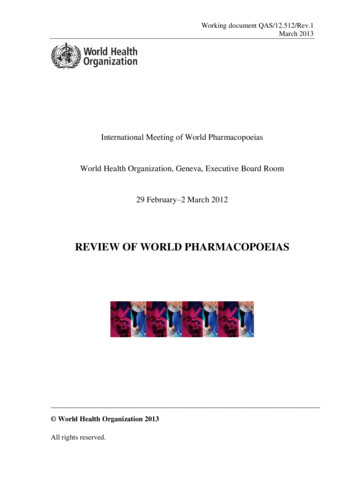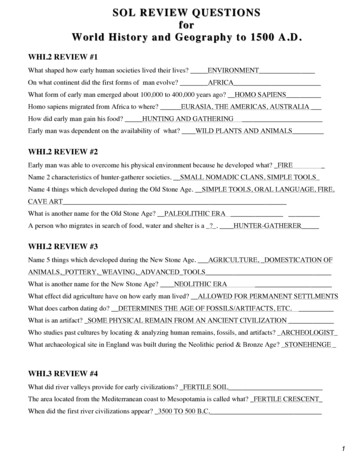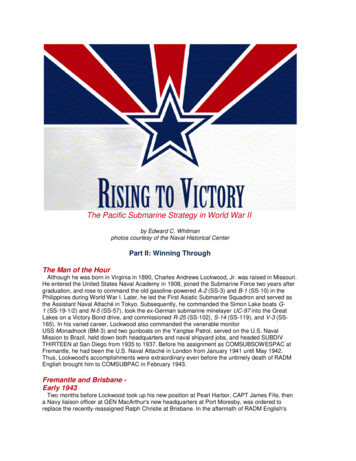
Transcription
Working document QAS/12.512/Rev.1March 2013International Meeting of World PharmacopoeiasWorld Health Organization, Geneva, Executive Board Room29 February–2 March 2012REVIEW OF WORLD PHARMACOPOEIAS World Health Organization 2013All rights reserved.
Working document QAS/12.512/Rev.1page 2ContentsPage1.Introduction.32.History and background .43.Questions to pharmacopoeias .4Name of the pharmacopoeia, latest publication and update frequency .5Legal basis and references to other pharmacopoeias .7For which products does the pharmacopoeia provide specifications? . 11Collaboration with and/or being part of a (different) national/regionalpharmacopoeia .13Publication of harmonized pharmacopoeial texts within the pharmacopoeia .15Interaction with stakeholders, including regulators . 16Strategy for the future . 164.References.20
Working document QAS/12.512/Rev.1page 31.IntroductionPharmacopoeia: the word derives from the ancient Greek φαρμακοποιΐα (pharmakopoiia),from φαρμακο- (pharmako-) ″drug″, followed by the verb-stem ποι- (poi-) ″make″ andfinally the abstract noun ending -ια (-ia). These three elements together can be rendered as″drug-mak-ing″ or ″to make a drug″.A pharmacopoeia, pharmacopeia, or pharmacopoea, in its modern sense, is a legallybinding collection, prepared by a national or regional authority, of standards and qualityspecifications for medicines used in that country or region. A quality specification iscomposed of a set of appropriate tests that will confirm the identity and purity of theproduct, ascertain the strength (or amount) of the active substance and, when needed, itsperformance characteristics. Reference substances, i.e. highly-characterized, physicalspecimens, are used in testing to help ensure the quality, such as identity, strength andpurity, of medicines. The texts cover pharmaceutical starting materials, excipients,intermediates and finished pharmaceutical products (FPPs). General requirements may alsobe given in the pharmacopoeia on important subjects related to medicines quality, such asanalytical methods, microbiological purity, dissolution testing, stability, etc. (1).The role of a modern pharmacopoeia is to furnish quality specifications for activepharmaceutical ingredients (APIs), FPPs and general requirements, e.g. for dosage forms.The existence of such specifications and requirements is necessary for the properfunctioning or regulatory control of medicines. Pharmacopoeial requirements form a basefor establishing quality requirements for individual pharmaceutical preparations in theirfinal form. According to the information available to the World Health Organization(WHO), 140 independent countries are at present employing some 30 national as well asthe African, European and International Pharmacopoeias (2). Compared to national andregional pharmacopoeias, The International Pharmacopoeia (Ph. Int.) is issued by WHOas a recommendation with the aim to provide international standards – including lesstechnically demanding alternatives where needed - for adoption by Member States and tohelp achieve a potentially global uniformity of quality specifications for selectedpharmaceutical products, excipients and dosage forms.After discussion with many representatives of world pharmacopoeias and in response tofeedback, WHO has initiated steps based on WHO's first attempts during various meetingsof the International Conference of Drug Regulatory Authorities (ICDRA), especially the10th ICDRA meeting held in Hong Kong in 2002 and a further discussion amongregulators during the 11th ICDRA meeting held in Madrid in 2004, to organize an officialmeeting entitled International meeting of world pharmacopoeias for participation of allWHO Member States' pharmacopoeias worldwide, be they national, regional orinternational. The aim was to discuss topics of common interest and challenges. Themeeting dates were 29 February–2 March 2012. In order to prepare for the meeting in atimely manner, WHO sent a preliminary agenda and Questions to pharmacopoeias inadvance to receive feedback and enable comprehensive input to the agenda. Thequestions, participants‘ presentations and the meeting report are shown on the meeting website (3).This document presents a summary of the answers to the Questions to pharmacopoeiasprovided by representatives of world pharmacopoeias participating in the internationalmeeting, and of other related information received from those that were unable to activelyparticipate in this meeting.
Working document QAS/12.512/Rev.1page 42.History and backgroundOverwhelming empirical knowledge of mankind gained during centuries and constanteffort to establish better health care possibilities have led to the creation of a list of origin,preparation and healing properties of medicines.The term Pharmacopoeia first appears as a distinct title in a work published in Basel,Switzerland in 1561 by Dr A. Foes, but does not appear to have come into general use untilthe beginning of the 17th century. Today’s pharmacopoeias focus mainly on assurance ofquality of products by various tools of analytical sciences.The aim to achieve a wide global harmonization of quality specifications for selectedpharmaceutical products, excipients and dosage forms came with increased globalizationand reciprocal collaboration. History of these approaches goes back to 1902–1925 whenagreements established a ″Unified″ Pharmacopoeia. In 1929 the "Brussels Agreement"stipulated the League of Nations to carry out related administrative functions. Eight yearslater, in 1937, the first meeting of the ″Technical Commission of Pharmaceutical Experts″was held. An important date in the history of quality assurance of medicines is 1948, whenthe First World Health Assembly (WHA) approved the Expert Committee on Unificationof Pharmacopoeias to continue this work. One year later, the WHA renamed it the ExpertCommittee on International Pharmacopoeia (1).Attendees at the ICDRA side meetings and ICDRA sessions thereafter championed theneed for a worldwide approach in terms of pharmacopoeial specifications, especially statedby the participants from Brazil, China, Czech Republic, India, Russian Federation,Thailand, Zimbabwe and by telephone with the Council of Europe and the United StatesPharmacopeia (USP). Recommendations emerged from these side meetings, includingholding an international meeting for those involved in the development of pharmacopoeialspecifications, putting the topic of pharmacopoeias on the agenda of the forthcomingICDRA, encouraging international harmonization efforts by WHO to develop commonspecifications and international reference standards with special focus on those for whichno pharmacopoeial monographs exist as yet, making all efforts to help combat counterfeitdrugs, reinforcing the close links between regulatory authorities and pharmacopoeias, anddiscussing the importance of impurity profiles and limits at an international level,especially for internationally-traded starting materials.3.Questions to pharmacopoeiasThis summary is based on the answers to the Questions to pharmacopoeias (below)provided by representatives of world pharmacopoeias participating in the 2012international meeting at WHO headquarters.Box 1. Questions to pharmacopoeias1.Name of pharmacopoeia2.Pharmacopoeia referred to in national/regional legislations - if yes, which?3.National/regional legislation includes reference to other - national, regional, internationalpharmacopoeias(s) - if yes, which?4.Publication of latest edition5.Update frequency - Annually, biannually, other (please specify)6.For which products does the pharmacopoeia provide specifications?APIs, dosage forms, herbal products, biologicals, traditional medicines, etc. (please specify)
Working document QAS/12.512/Rev.1page 57.Number of texts included in the pharmacopoeiaMonographs for APIs, finished dosage forms, biologicals, general monographs8.Collaboration with and/or being part of a (different) national/regional pharmacopoeia if yes, which?9.Publication of harmonized pharmacopoeial texts within the pharmacopoeiaif yes, which pharmacopoeia, which type, how many?10.Interaction with stakeholders, including regulators?11.Strategy for the future?Name of the pharmacopoeia, latest publication and update frequencyThe pharmacopoeia, as a public tool, maintains quality of medicines by collecting therecommended procedures for analysis and specifications for the determination of e.g.pharmaceutical substances, excipients and dosage forms, and in most cases consists of ageneral part (tests, methods and general requirements) and a specific part in the form ofmonographs, i.e. monographs for pharmaceutical substances. Pharmaceutical analysis as anexact science represents a platform through which state-of-the-art research can affectquality safety and efficacy of medicines directly by applying those scientific results intoeveryday practice by pharmacopoeias. Transparency and scientific progress are the drivingengines behind the need to constantly update all pharmacopoeias. Despite differences inlanguage and medicines regulation among countries all around the world,internationalization and unifying principles in terms of maintaining quality of medicinesshould be discussed to establish proper medicines for all.To keep countries' pharmacopoeias up-to-date for the reasons mentioned above,pharmacopoeial commissions constantly update their pharmacopoeias. The updatesthemselves are performed by publishing supplements and addenda or by partial revision.More than half the pharmacopoeias represented by the participating delegations,pharmacopoeias are being updated annually. See the table below with comprehensiveinformation about the name of the world pharmacopoeias, their update frequency and latesteditions.Table 1. Names, update frequencies and latest editions of pharmacopoeiasScopeOrganization,region orcountryInternational:World HealthOrganization(Ph. Eur. Obs.)Regional:European UnionNational :CroatiaName ofpharmacopoeiaThe eia(Ph. Eur.)EuropeHrvatska FarmakopejaCzech Republic Český lékopisUpdate frequencyLatest editionYearAnnually4th Edition, Vols 1, 22nd Supplement20062011New Edition every threeyears. Supplements threetimes a year (Mar, Jun,Nov)(Ph. Eur. Members)(Translation does notfollow the frequency ofpublication of Ph. Eur.)Annually as Supplements7th Edition (7.0)7th Edition (7.4)20102012CroatianPharmacopoeia withcommentsEdition (MMIX)Supplement20072012
Working document QAS/12.512/Rev.1page 6ScopeOrganization,region orcountryFinlandName ofpharmacopoeiaUpdate frequencyLatest editionYearPh. Eur.(see Ph. Eur.)(see Ph. Eur.)FrancePharmacopée françaiseGermanyAnnually; since 199811th Editionconsists of three foldersregularly updated; since the4th Ed, two per yearUpdated annuallyDAB 2011(seePh. Eur.)April2012SwedenDeutsches Arzneibuch(DAB)Farmacopeia Portuguesa Published every 4 years,with 3 supplementsannuallyYugoslavN/APharmacopoeiaReal FarmacopeaPlanned to follow the sameEspañolafrequency as the Ph. Eur.Ph. Eur.(see Ph. Eur.)SwitzerlandPharmacopoea Helvetica Annually or biannuallyUnitedKingdom (UK)National:Kazakhstan (Ph.Eur. Obs.)British PharmacopoeiaPortugalSerbiaSpainRussianFederation (Ph.Eur. Obs.)Ukraine (Ph.Eur. Obs.)National:China (Ph. Eur.Obs.) *IndiaEastern Europe andCentral AsiaThe State PharmacoN/Apoeia of the Republic ofKazakhstanState Pharmacopoeia of Once in 5 yearsthe Russian FederationThe State Pharmacopoeia of UkraineAsiaPharmacopoeia of thePeople's Republic ofChinaIndian Pharmacopoeia(IP)IndonesiaFarmakope IndonesiaJapanThe JapanesePharmacopoeia (JP)Korea*AnnuallyThe KoreanPharmacopoeiaNational:North AmericaUnited States of United StatesAmericaPharmacopeia (USP)(Ph. Eur. Obs.)National:Latin AmericaArgentinaFarmacopea Argentina(Ph. Eur. Obs.)9th Edition,Vol. 1,Vol. 2,Vol. 3Supplement 9.8Translation of Ph. Eur.3rd Ed.4th Edition(see Ph. Eur.)10th EditionSupplement 10.3BP20112008201019972011(seePh. Eur.)2006201020131st Edition1, 2 volumes200812th Edition, Vol. 12007Bianually1st EditionSupplement 420012011Once every five years9th Edition2010Once every four years inbetween an Addendum6th Edition, IP2010 Addendum 2012to IP-2010Updated annually by f4th Editionsupplement and once every 3rd Supplement5 years as a new editionOnce every 5 years sinceJP16JP9; two supplementsSupplement I to JP16between the editions afterJP12 and partial revision atany time if immediatenecessityCurrently revised in every 9th Edition5-year termSupplement 720102012Annually, with 2supplements per yearUSP 35-NF 30Supplement20112012Undetermined, intendedbianually8th Edition*(vol.1,2,3,4)2011199520112011201220072011
Working document QAS/12.512/Rev.1page 7ScopeOrganization,region orcountryBrazil(Ph. Eur. Obs.)MexicoName ofpharmacopoeiaUpdate frequencyLatest editionYearFarmacopéia BrasileiraNo defined periodicity5th Edition, Vols 1, 22010Annual update10th EditionSupplement20112012Farmacopea de losEstados UnidosMexicanos(Ph. Eur. Obs.) Ph. Eur. Observer* Not represented at the meeting.Legal basis and references to other pharmacopoeiasPharmacopoeias are referred to in legislation which puts them into force in the relevantcountry o
British Pharmacopoeia Annually BP 2013 National: Eastern Europe and Central Asia Kazakhstan (Ph. Eur. Obs.) The State Pharmaco-poeia of the Republic of Kazakhstan N/A 1st Edition 1, 2 volumes 2008 Russian Federation (Ph. Eur. Obs.) State Pharmacopoeia of the Russian Federation Once in 5 years 12th Edition, Vol. 1 2007 Ukraine (Ph. Eur. Obs.) The State Pharmaco-poeia of Ukraine Bianually 1st .File Size: 790KBPage Count: 20











